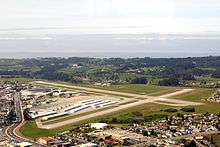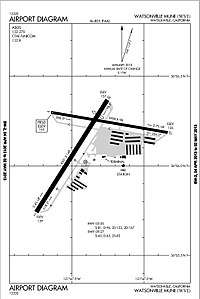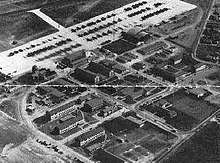Watsonville Municipal Airport
Watsonville Municipal Airport (IATA: WVI, ICAO: KWVI, FAA LID: WVI) is three miles (5 km) northwest of Watsonville, in Santa Cruz County, California, United States.[1] The airport covers 330 acres (134 ha) and has two runways. The largest aircraft to ever land at Watsonville were 05-5141 and 05-5143, C-17 Globemaster IIIs from March ARB, California.
Watsonville Municipal Airport | |||||||||||||||
|---|---|---|---|---|---|---|---|---|---|---|---|---|---|---|---|
 Photo of Watsonville Municipal Airport | |||||||||||||||
 Airport diagram | |||||||||||||||
| Summary | |||||||||||||||
| Airport type | Public | ||||||||||||||
| Operator | City of Watsonville | ||||||||||||||
| Location | Watsonville, California | ||||||||||||||
| Elevation AMSL | 163 ft / 50 m | ||||||||||||||
| Coordinates | 36°56′09″N 121°47′23″W | ||||||||||||||
| Map | |||||||||||||||
 WVI | |||||||||||||||
| Runways | |||||||||||||||
| |||||||||||||||
Facilities
The airport's longest runway is 02-20, 4501' x 149'. The crosswind runway, 09-27, 3998' x 98', is used when winds favor it and when fog is moving across the field from Monterey Bay.
The airport is uncontrolled, and the CTAF is 122.8 MHz, and the ASOS can be received on 132.275 MHz or by calling 831-724-8794.
History

The Navy took over in July, 1943, purchased an additional 35 acres, built support buildings and the concrete ramp. On October 23, 1943, the airport was commissioned as Naval Air Auxiliary Station Watsonville (NAAS Watsonville) and served as a satellite to Naval Air Station (NAS) Alameda. NAAS Watsonville provided training and maintenance for the 12th Naval District, Alameda, California under the Bureau of Yards and Docks, under the command of Lieutenant John C. Chapman. Antisubmarine [Blimp]]s in the defense of California from Moffett Field were stationed at NAAS Watsonville. Other aircraft stationed at the base were Grumman F6F Hellcat with the VF-8 and VBF-8. Up to 75 combat aircraft were stationed at the base. Also based at the airfield were Grumman TBF Avenger, Vought F4U Corsair and Douglas SBD Dauntless. These were used for the 90- to 120-day training classes, in torpedo, dive bomber and fighter operations. As the World War II ended, so did operations at NAAS Watsonville, on November 1, 1945 it was closed and placed on caretaker status. The NAAS Watsonville was returned to the city in 1947.[2][3]
Instrument approaches
The airport has three documented instrument approach procedures, making it a popular instrument training area.
- Localizer Runway 02 (requires overwater flight)
- RNAV (GPS) Runway 02 (requires overwater flight, LPV/WAAS minimums)
- VOR/DME-A (from Salinas VOR)
Instrument pilots have been advised that Watsonville is occasionally surrounded by non-IFR traffic that climbs or descends to low stratus layers in violation of regulations. Air traffic control (ATC) usually calls them out, but they cannot always see them. There are frequent radio calls to the common traffic advisory frequency (CTAF), even when instrument meteorological conditions (IMC) prevail.
See also
- Old Watsonville Airport (1930-1947)
- List of airports of Santa Cruz County, California
- List of airports in the San Francisco Bay Area
- California during World War II
References
External links
- Watsonville Municipal Airport (official site)
- Watsonville Fly In and Airshow
- Watsonville Pilots Association
- Experimental Aircraft Association: Chapter 119
- Monterey Bay Ninety-Nines - local chapter of Ninety Nines organization for women pilots
- CAP Senior Squadron 13 - local Civil Air Patrol squadron, search & rescue and aviation education
- AirMonterey, LLC Part 135 On-Demand Air Charter (Passengers/Cargo)
- Ocean Air Flight Services Flight Training and Maintenance
- United Flight Services Flight Training FBO
- Santa Cruz Flying Club Non-profit Flying Club
- West Coast Sport Aircraft TECNAM Aircraft Regional Distributor
- "Watsonville Airport is a wonderful asset for the city", article in Watsonville Register-Pajaronian, 2009-08-18
- FAA Airport Master Record for WVI (Form 5010 PDF)
- Resources for this airport:
- FAA airport information for WVI
- AirNav airport information for KWVI
- ASN accident history for WVI
- FlightAware airport information and live flight tracker
- NOAA/NWS weather observations: current, past three days
- SkyVector aeronautical chart, Terminal Procedures
